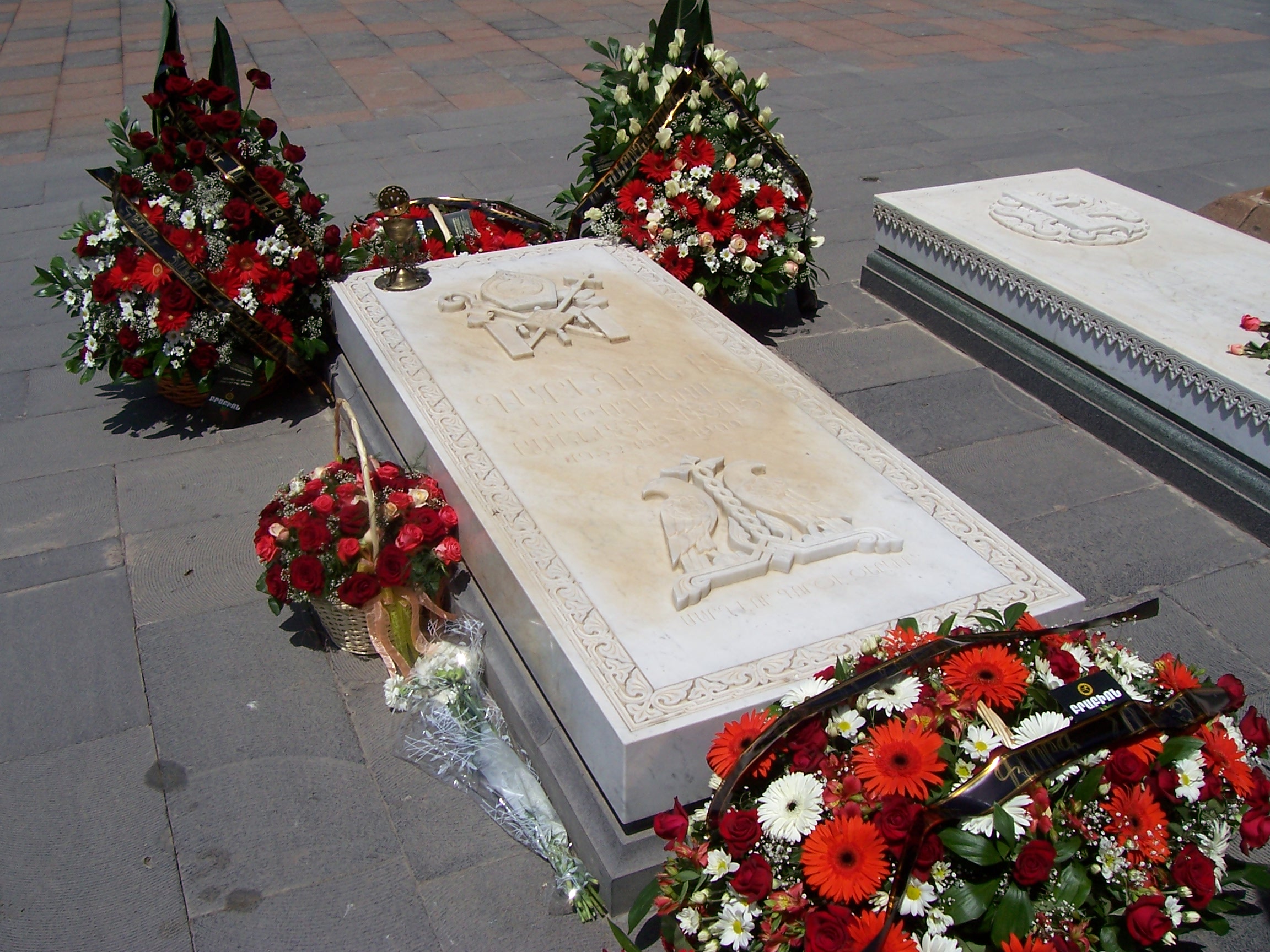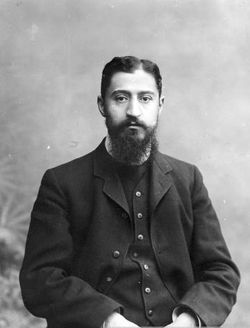|
Karekin I Centre Of Theology And Armenology
Karekin I Centre of Theology and Armenology ( hy, Գարեգին Ա Աստվածաբանական-հայագիտական կենտրոն, ''Garegin A Astvatsabanakan-hayagitakan kentron''), is an educational institution and a research centre of the Mother See of Holy Etchmiadzin, located in Vagharshapat, Armenia. It was officially founded on 26 June 2000, by Catholicos Karekin II. Named after Catholicos Karekin I of All Armenians, the centre is located within the complex of the Mother See. Its goal is to promote the development of theological studies and Christian education, medieval Armenian literature studies, teaching the Armenian language in foreign countries, manuscript studies, documentation and archiving skills, etc. The director of the Center is Dr. Azat Bozoyan. The center's business operations and assists management in the Gevorkian Theological Seminary seminarians, as well as clergymen. The Library The centers is in coordination with a number of institutions including t ... [...More Info...] [...Related Items...] OR: [Wikipedia] [Google] [Baidu] |
Mother See Of Holy Etchmiadzin
Mother See of Holy Etchmiadzin ( hy, Մայր Աթոռ Սուրբ Էջմիածին, translit=Mayr At’oř Surb Ēĵmiatsin), known in Armenian as simply the Mother See (Մայր Աթոռ, ''Mayr At’oř''), is the governing body of the Armenian Apostolic Church. It is headquartered around Etchmiadzin Cathedral in Vagharshapat (Etchmiadzin), Armenia and is the seat of the Catholicos of All Armenians, the head of the church. Organizational structure of the Mother See The organizational structure of the Mother See of Holy Etchmiadzin is composed of spiritual and administrative bodies representing the authority of the Armenian Church, as follows: Supreme Spiritual Council The Supreme Spiritual Council ( hy, Գերագոյն Հոգեւոր Խորհուրդ ''Geraguyn Hokevor Khorhurt'') is headed by the Catholicos of All Armenians. It is the highest executive body of the Armenian Apostolic Church. Members of the Spiritual Council are either elected by the National Ecclesiastical ... [...More Info...] [...Related Items...] OR: [Wikipedia] [Google] [Baidu] |
Vagharshapat
Vagharshapat ( hy, Վաղարշապատ ) is the 4th-largest city in Armenia and the most populous municipal community of Armavir Province, located about west of the capital Yerevan, and north of the closed Turkish-Armenian border. It is commonly known as Ejmiatsin (also spelled Echmiadzin or Etchmiadzin, , ), which was its official name between 1945 and 1995. It is still commonly used colloquially and in official bureaucracy (dual naming). The city is best known as the location of Etchmiadzin Cathedral and Mother See of Holy Etchmiadzin, the center of the Armenian Apostolic Church. It is thus unofficially known in Western sources as a "holy city" and in Armenia as the country's "spiritual capital" (). It was one of the major cities and a capital of the ancient Kingdom of Greater Armenia. Reduced to a small town by the early 20th century, it experienced large expansion during the Soviet period becoming, effectively, a suburb of Yerevan. Its population stands just over 37,000 ... [...More Info...] [...Related Items...] OR: [Wikipedia] [Google] [Baidu] |
Armenia
Armenia (), , group=pron officially the Republic of Armenia,, is a landlocked country in the Armenian Highlands of Western Asia.The UNbr>classification of world regions places Armenia in Western Asia; the CIA World Factbook , , and ''Oxford Reference Online'' also place Armenia in Asia. It is a part of the Caucasus region; and is bordered by Turkey to the west, Georgia to the north, the Lachin corridor (under a Russian peacekeeping force) and Azerbaijan to the east, and Iran and the Azerbaijani exclave of Nakhchivan to the south. Yerevan is the capital, largest city and the financial center. Armenia is a unitary, multi-party, democratic nation-state with an ancient cultural heritage. The first Armenian state of Urartu was established in 860 BC, and by the 6th century BC it was replaced by the Satrapy of Armenia. The Kingdom of Armenia reached its height under Tigranes the Great in the 1st century BC and in the year 301 became the first state in the world to adopt ... [...More Info...] [...Related Items...] OR: [Wikipedia] [Google] [Baidu] |
Karekin II
Catholicos Karekin II ( hy, Գարեգին Բ, also spelled Garegin; born 21 August 1951) is the current Catholicos of All Armenians, the supreme head of the Armenian Apostolic Church. In 2013 he was unanimously elected the Oriental Orthodox head of the World Council of Churches for the next eight years. Biography Karekin II was born as Ktrij Nersessian in Voskehat, Armenia, on 21 August 1951. He entered the Gevorkian Theological Seminary at Echmiadzin in 1965 and graduated with honours in 1971. He was ordained to the diaconate in 1970. Later he became a monk and was ordained a priest in 1972. In the late 1970s the Catholicos of that period encouraged him to study outside of Armenia. This led to him continuing his studies in Vienna, Bonn University, and Zagorsk, Russia. On 23 October 1983, he was consecrated bishop at Echmiadzin. He became an archbishop in 1992. Karekin II speaks fluent German from his time in Germany and Austria. In 1975 during his time in Cologne he was the ... [...More Info...] [...Related Items...] OR: [Wikipedia] [Google] [Baidu] |
Karekin I
Karekin I ( Armenian: ) (August 27, 1932 – June 29, 1999) served as the Catholicos of the Armenian Apostolic Church between 1994 and 1999. Previously, he served as the Catholicos of Cilicia from 1983 to 1994 as Karekin II ( Armenian: ). Beginnings Karekin, born and baptized as Neshan Sarkissian, was born in the Armenian-populated village of Kesab in northern Syria, where he attended the Armenian elementary school. In 1946 he was admitted to the Theological Seminary of the Armenian Catholicosate of Cilicia and in 1949 ordained a deacon. In 1952, after having graduated with high honors, he was ordained a celibate priest and took the ecclesiastical name Karekin. He joined the order of the Armenian Catholicosate of Cilicia. In 1955, he presented his doctoral thesis on the subject "The Theology of the Armenian Church, According to Liturgical Hymns Sharakans" and was promoted to the ecclesiastical degree of vardapet (archimandrite). In next year he served as a member of the fa ... [...More Info...] [...Related Items...] OR: [Wikipedia] [Google] [Baidu] |
Armenian National Academy Of Sciences
The National Academy of Sciences of the Republic of Armenia (NAS RA) ( hy, Հայաստանի Հանրապետության գիտությունների ազգային ակադեմիա, ՀՀ ԳԱԱ, ''Hayastani Hanrapetut’yan gitut’yunneri azgayin akademia'') is the Armenian national academy, functioning as the primary body that conducts research and coordinates activities in the fields of science and social sciences in Armenia. It is a member of the International Science Council. History The Academy of Sciences of the Armenian Soviet Socialist Republic was founded on 10 November 1943, on the basis of the Armenian Branch of the Soviet Academy of Sciences, which was established almost 10 years earlier, in 1935. Among its founders were Joseph Orbeli, Stepan Malkhasyants, Ivan Gevorkian and Victor Ambartsumian; Orbeli became the first president of the academy. Presidents *Joseph Orbeli (1943–1947) *Victor Ambartsumian (1947–1993) *Fadey Sargsyan (1993–2006) * Radik Martiro ... [...More Info...] [...Related Items...] OR: [Wikipedia] [Google] [Baidu] |
Gevorkian Theological Seminary
Gevorkian Theological Seminary ( hy, Գևորգյան Հոգևոր Ճեմարան ''Gevorkyan Hogevor Č̣emaran''), also known as Gevorkian Seminary ( hy, Գևրգյան Ճեմարան ''Gevorkyan Č̣emaran'', ), is a theological university-institute of the Armenian Apostolic Church founded by Catholicos George IV in 1874. It is located in the town of Vagharshapat (Etchmiadzin) within the complex of the Mother See of Holy Etchmiadzin, Armenia. Gevorkian Seminary is considered the oldest university in modern Armenia. History During the tenure of Catholicos Gevorg IV (1866–1884), he called for the creation of a theological school at the Mother See of Holy Etchmiadzin to meet the educational needs of the clergy. In the summer of 1872 he called upon Archimandrites Gevork Surenian, Vahan Bastanian, Vahram Mankuni and Aristakes Sedrakian to facilitate the re-establishment of the historic school. It was decided to open a new seminary. Nineteenth century On 18 May 1869, the corners ... [...More Info...] [...Related Items...] OR: [Wikipedia] [Google] [Baidu] |
National Library Of Armenia
The National Library of Armenia ( hy, (''Hayastani Azgayin Gradaran'')) is a national public library in Yerevan, Armenia. It was founded in 1832 as part of the state gymnasium-school of Yerevan. It is the official cultural repository for the entire republic. The current building of the library, dating back to 1939, is on Teryan street within the Kentron district. It was designed by architect Alexander Tamanyan to house around seven million books. Between 1925 and 1990, the library was named after Aleksandr Myasnikyan. Currently, the library is home to a collection of 6.6 million books. Oldest units *The oldest printed book in the library is Urbatagirk, published in Venice, 1512. *The oldest map in the library dates back to 1695, published in Amsterdam. *The oldest newspaper in the library is Azdarar, published in Madras, 1794. See also *List of libraries *List of national and state libraries *Matenadaran References External linksOfficial Website of the National Library of ... [...More Info...] [...Related Items...] OR: [Wikipedia] [Google] [Baidu] |
Yerevan State University
Yerevan State University (YSU; hy, Երևանի Պետական Համալսարան, ԵՊՀ, ''Yerevani Petakan Hamalsaran''), also simply University of Yerevan, is the oldest continuously operating public university in Armenia. Founded in 1919, it is the largest university in the country. It is thus informally known as Armenia's "mother university" (Մայր ԲՈւՀ, ''Mayr Buh''). Of its 3,150 employees, 1,190 comprise the teaching staff, which includes 25 academicians, 130 professors, 700 docents (associate professors), and 360 assistant lecturers. The university has 400 researchers, 1,350 post-graduate students, and 8,500 undergraduates, including 300 students from abroad. Instruction is in Armenian, but instruction in Russian or English for foreign students is available as needed. The academic year is from September 1 through June 30. According to University Ranking by Academic Performance (URAP), it was the top-ranked university in Armenia and the 954th in the world in 2 ... [...More Info...] [...Related Items...] OR: [Wikipedia] [Google] [Baidu] |
Armenian Studies
Armenian studies or Armenology ( hy, հայագիտություն, ) is a field of humanities covering Armenian history, language and culture. The emergence of modern Armenian studies is associated with the foundation of the Catholic Mechitarist order in the early 18th century. Until the early 20th century, Armenian studies were largely conducted by individual scholars in the Armenian communities of the Russian Empire (Moscow, Saint Petersburg, New Nakhichevan, Tiflis), Europe (Venice, Vienna, Paris, London, Berlin, Leipzig), Constantinople and Vagharshapat in Armenia. After the establishment of Soviet rule, Armenian studies, and sciences in general, were institutionalized in Armenia and put under direct control of the Academy of Sciences. Today, numerous research centers in many parts of the world specialize in Armenian studies. Notable scholars who have worked in the field of Armenian studies Early scholars * Maturin Veyssière La Croze (1661–1739), historian and orientalist ... [...More Info...] [...Related Items...] OR: [Wikipedia] [Google] [Baidu] |
Armenian Schools
Schools and universities in Armenia Some of universities in Armenia: *American University of Armenia *Yerevan State University *Yerevan State Medical UniversityRussian-Armenian State UniversityYerevan, ArmeniaUniversité Française en ArménieYerevan, ArmeniaYerevan, ArmeniaYerevan Physics InstituteYerevan, ArmeniaYerevan State Academy of Fine ArtsYerevan, ArmeniaYerevan State Linguistic UniversityYerevan, ArmeniaNational Academy of Sciences of Armenia * Schools outside Armenia Armenian Elementary Schools ;Greece *Zavarian Elementary ...[...More Info...] [...Related Items...] OR: [Wikipedia] [Google] [Baidu] |




